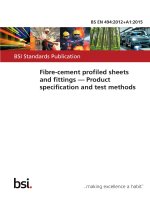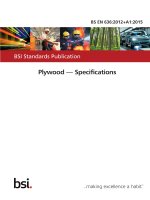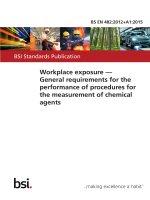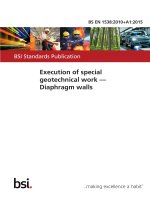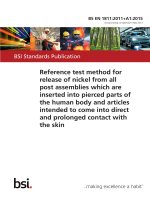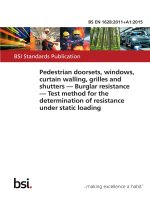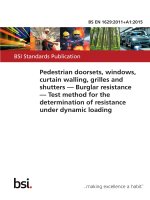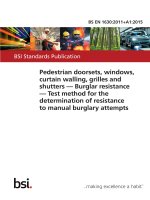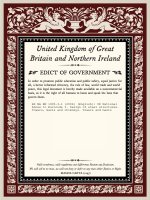Bsi bs en 61400 27 1 2015
Bạn đang xem bản rút gọn của tài liệu. Xem và tải ngay bản đầy đủ của tài liệu tại đây (2.3 MB, 100 trang )
BS EN 61400-27-1:2015
BSI Standards Publication
Wind Turbines
Part 27-1: Electrical simulation models —
Wind turbines
BS EN 61400-27-1:2015 BRITISH STANDARD
National foreword
This British Standard is the UK implementation of EN 61400-27-1:2015.
It is identical to IEC 61400-27-1:2015.
The UK participation in its preparation was entrusted by Technical
Committee PEL/88, Wind turbines, to Panel PEL/88/-/6, Simulation models
for wind power generation.
A list of organizations represented on this committee can be obtained on
request to its secretary.
This publication does not purport to include all the necessary provisions of
a contract. Users are responsible for its correct application.
© The British Standards Institution 2015.
Published by BSI Standards Limited 2015
ISBN 978 0 580 78015 8
ICS 27.180
Compliance with a British Standard cannot confer immunity from
legal obligations.
This British Standard was published under the authority of the
Standards Policy and Strategy Committee on 31 October 2015.
Amendments/corrigenda issued since publication
Date Text affected
EUROPEAN STANDARD BS EN 61400-27-1:2015
NORME EUROPÉENNE
EUROPÄISCHE NORM EN 61400-27-1
ICS 27.180 October 2015
English Version
Wind turbines - Part 27-1: Electrical simulation models - Wind
turbines
(IEC 61400-27-1:2015)
Eoliennes - Partie 27-1: Modèles de simulation électrique - Windenergieanlagen - Teil 27-1: Elektrische
Eoliennes Simulationsmodelle - Windenergieanlagen
(IEC 61400-27-1:2015) (IEC 61400-27-1:2015)
This European Standard was approved by CENELEC on 2015-03-20. CENELEC members are bound to comply with the CEN/CENELEC
Internal Regulations which stipulate the conditions for giving this European Standard the status of a national standard without any alteration.
Up-to-date lists and bibliographical references concerning such national standards may be obtained on application to the CEN-CENELEC
Management Centre or to any CENELEC member.
This European Standard exists in three official versions (English, French, German). A version in any other language made by translation
under the responsibility of a CENELEC member into its own language and notified to the CEN-CENELEC Management Centre has the
same status as the official versions.
CENELEC members are the national electrotechnical committees of Austria, Belgium, Bulgaria, Croatia, Cyprus, the Czech Republic,
Denmark, Estonia, Finland, Former Yugoslav Republic of Macedonia, France, Germany, Greece, Hungary, Iceland, Ireland, Italy, Latvia,
Lithuania, Luxembourg, Malta, the Netherlands, Norway, Poland, Portugal, Romania, Slovakia, Slovenia, Spain, Sweden, Switzerland,
Turkey and the United Kingdom.
European Committee for Electrotechnical Standardization
Comité Européen de Normalisation Electrotechnique
Europäisches Komitee für Elektrotechnische Normung
CEN-CENELEC Management Centre: Avenue Marnix 17, B-1000 Brussels
© 2015 CENELEC All rights of exploitation in any form and by any means reserved worldwide for CENELEC Members.
Ref. No. EN 61400-27-1:2015 E
BS EN 61400-27-1:2015
EN 61400-27-1:2015
European foreword
The text of document 88/510/FDIS, future edition 1 of IEC 61400-27-1, prepared by IEC TC 88 "Wind
turbines" was submitted to the IEC-CENELEC parallel vote and approved by CENELEC as EN 61400-27-
1:2015.
The following dates are fixed:
• latest date by which the document has (dop) 2016-04-16
to be implemented at national level by (dow) 2018-03-20
publication of an identical national
standard or by endorsement
• latest date by which the national
standards conflicting with the
document have to be withdrawn
Attention is drawn to the possibility that some of the elements of this document may be the subject of
patent rights. CENELEC [and/or CEN] shall not be held responsible for identifying any or all such patent
rights.
Endorsement notice
The text of the International Standard IEC 61400-27-1:2015 was approved by CENELEC as a European
Standard without any modification.
In the official version, for Bibliography, the following note has to be added for the standard indicated:
IEC 61400-25 (Series) NOTE Harmonised as EN 61400-25 (Series).
2
BS EN 61400-27-1:2015
EN 61400-27-1:2015
Annex ZA
(normative)
Normative references to international publications
with their corresponding European publications
The following documents, in whole or in part, are normatively referenced in this document and are
indispensable for its application. For dated references, only the edition cited applies. For undated
references, the latest edition of the referenced document (including any amendments) applies.
NOTE 1 When an International Publication has been modified by common modifications, indicated by (mod), the relevant EN/HD
applies.
NOTE 2 Up-to-date information on the latest versions of the European Standards listed in this annex is available here:
www.cenelec.eu.
Publication Year Title EN/HD Year
IEC 60050 series series
IEC 61400-21 - International Electrotechnical Vocabulary - -
Wind turbines -- Part 21: Measurement and EN 61400-21
assessment of power quality characteristics
of grid connected wind turbines
3
– 2 – BS EN 61400-27-1:2015
IEC 61400-27-1:2015 IEC 2015
CONTENTS
FOREW ORD ........................................................................................................................... 7
INTRODUCTION ..................................................................................................................... 9
1 Scope ............................................................................................................................ 12
2 Normative references .................................................................................................... 12
3 Terms, definitions, abbreviations and subscripts............................................................12
3.1 Terms and definitions............................................................................................12
3.2 Abbreviations and subscripts ................................................................................ 17
3.2.1 Abbreviations................................................................................................. 17
3.2.2 Subscripts ..................................................................................................... 18
4 Symbols and units ......................................................................................................... 19
4.1 General................................................................................................................. 19
4.2 Symbols (units) ..................................................................................................... 19
5 Specification of models.................................................................................................. 21
5.1 Overview............................................................................................................... 21
5.2 General specifications...........................................................................................21
5.3 Model interface ..................................................................................................... 23
5.4 Parameters and initialisation .................................................................................24
5.4.1 General ......................................................................................................... 24
5.4.2 Parameter categories .................................................................................... 24
5.4.3 Global parameters ......................................................................................... 24
5.4.4 Initialisation ................................................................................................... 24
5.5 Modular structure of models..................................................................................25
5.5.1 Generic modular structure .............................................................................25
5.5.2 Type 1 ........................................................................................................... 26
5.5.3 Type 2 ........................................................................................................... 28
5.5.4 Type 3 ........................................................................................................... 30
5.5.5 Type 4 ........................................................................................................... 33
5.6 Module library ....................................................................................................... 37
5.6.1 Aerodynamic models ..................................................................................... 37
5.6.2 Mechanical models ........................................................................................ 38
5.6.3 Generator set models ....................................................................................39
5.6.4 Electrical equipment ...................................................................................... 44
5.6.5 Control models .............................................................................................. 44
5.6.6 Grid protection model ....................................................................................55
6 Specification of validation procedure ............................................................................. 57
6.1 Overview............................................................................................................... 57
6.2 General specifications...........................................................................................58
6.3 Validation procedure ............................................................................................. 59
6.3.1 Voltage dips .................................................................................................. 59
6.3.2 Reference point changes ............................................................................... 64
6.3.3 Grid protection...............................................................................................64
Annex A (informative) Validation test documentation............................................................66
A.1 General................................................................................................................. 66
A.2 Simulation model and validation setup information ................................................66
A.3 Template for validation test results .......................................................................66
BS EN 61400-27-1:2015 – 3 –
IEC 61400-27-1:2015 IEC 2015
A.3.1 General ......................................................................................................... 66
A.3.2 Voltage dips .................................................................................................. 67
A.3.3 Reference point changes ............................................................................... 67
A.3.4 Grid protection...............................................................................................68
Annex B (normative) Limits to possible model accuracy .......................................................69
B.1 General................................................................................................................. 69
B.2 Inevitable simulation errors ...................................................................................69
B.3 Measurement errors .............................................................................................. 69
Annex C (normative) Digital 2nd order critically damped low pass filter .................................71
Annex D (informative) Simplified plant level model...............................................................72
D.1 General................................................................................................................. 72
D.2 Area of application ................................................................................................ 72
D.3 Voltage and reactive power controller model description .......................................72
D.4 Frequency and active power controller model description...................................... 74
Annex E (informative) Two-dimensional aerodynamic model ................................................ 76
E.1 Objective .............................................................................................................. 76
E.2 Model approach .................................................................................................... 76
E.3 Model parameter fits ............................................................................................. 77
E.4 Use cases ............................................................................................................. 80
E.4.1 General ......................................................................................................... 80
E.4.2 Stability study use cases ...............................................................................80
E.4.3 Validation use cases......................................................................................80
E.5 Model initialisation at derated conditions...............................................................80
Annex F (informative) Generic Software Interface for use of models in different
software environments .......................................................................................................... 81
F.1 Description of the approach .................................................................................. 81
F.2 Description of the Software interface ....................................................................82
F.2.1 Description of data structures ........................................................................ 82
F.2.2 Functions for communication through the ESE-interface ................................83
F.2.3 Inputs, Outputs, Parameters ..........................................................................85
Annex G (normative) Block symbol library............................................................................ 86
G.1 General................................................................................................................. 86
G.2 Time step delay .................................................................................................... 86
G.3 Stand-alone ramp rate limiter ................................................................................86
G.4 First order filter with absolute limits, rate limits and freeze flag .............................87
G.5 Lookup table ......................................................................................................... 88
G.6 Comparator...........................................................................................................88
G.7 Timer ....................................................................................................................88
G.8 Anti windup integrator ........................................................................................... 89
G.9 Integrator with reset .............................................................................................. 90
G.10 First order filter with limitation detection................................................................90
G.11 Delay flag ............................................................................................................. 91
G.12 Raising edge detection ......................................................................................... 91
Bibliography.......................................................................................................................... 93
Figure 1 – Classification of power system stability according to IEEE/CIGRE Joint Task
Force on Stability Terms and Definitions .................................................................................9
Figure 2 – Example of step response. ...................................................................................15
– 4 – BS EN 61400-27-1:2015
IEC 61400-27-1:2015 IEC 2015
Figure 3 – General interface between WT model, grid model and WP model .........................23
Figure 4 – General interface for initialisation of WT model, WP model and grid model. .........25
Figure 5 – Generic modular structure of WT models..............................................................26
Figure 6 – Main electrical and mechanical components of type 1 WTs ..................................26
Figure 7 – Modular structure for the type 1A WT model......................................................... 27
Figure 8 – Modular structure for the type 1B WT model......................................................... 28
Figure 9 – Main electrical and mechanical components of type 2 WTs ..................................29
Figure 10 – Modular structure for the type 2 WT model ......................................................... 29
Figure 11 – Modular structure for the type 2 control model.................................................... 30
Figure 12 – Main electrical and mechanical components of type 3 WTs ................................31
Figure 13 – Modular structure for the type 3 WT model ......................................................... 31
Figure 14 – Modular structure for the type 3 control models .................................................. 32
Figure 15 – Main electrical and mechanical components of type 4 WTs ................................33
Figure 16 – Modular structure for the type 4A WT model....................................................... 34
Figure 17 – Modular structure for the type 4A control model ................................................. 34
Figure 18 – Modular structure for the type 4B WT model....................................................... 35
Figure 19 – Modular structure for the type 4B control model ................................................. 36
Figure 20 – Block diagram for constant aerodynamic torque model .......................................37
Figure 21 – Block diagram for one-dimensional aerodynamic model .....................................37
Figure 22 – Block diagram for two-dimensional aerodynamic model ......................................38
Figure 23 – Block diagram for two mass model .....................................................................39
Figure 24 – Block diagram for type 3A generator set model .................................................. 40
Figure 25 – Block diagram for type 3B generator set model .................................................. 42
Figure 26 – Block diagram for type 4 generator set model..................................................... 43
Figure 27 – Block diagram for the reference frame rotation model.........................................44
Figure 28 – Block diagram for pitch control power model ......................................................45
Figure 29 – Block diagram for pitch angle control model .......................................................46
Figure 30 – Block diagram for rotor resistance control model ................................................47
Figure 31 – Block diagram for type 3 P control model ........................................................... 48
Figure 32 – Block diagram for type 3 torque PI ..................................................................... 49
Figure 33 – Block diagram for type 4A P control model ......................................................... 49
Figure 34 – Block diagram for type 4B P control model ......................................................... 50
Figure 35 – Block diagram for Q control model......................................................................52
Figure 36 – Block diagram for current limiter.........................................................................54
Figure 37 – Block diagram for constant Q limitation model ....................................................54
Figure 38 – Block diagram for QP and QU limitation model ...................................................55
Figure 39 – Block diagram for grid protection system ............................................................ 56
Figure 40 – Block diagram for u-f measurement ....................................................................57
Figure 41 – Signal processing structure with "play-back" method applied..............................60
Figure 42 – Signal processing structure with "full grid simulation" method applied. ...............61
Figure 43 – Voltage dip windows........................................................................................... 63
Figure D.1 – Block diagram for WP reactive power controllers ..............................................74
Figure D.2 – Block diagram for WP active power controller ...................................................75
BS EN 61400-27-1:2015 – 5 –
IEC 61400-27-1:2015 IEC 2015
Figure E.1 – Aerodynamic power as function of blade angle Θ and wind speed v .................77
Figure E.2 – Partial derivative of power with respect to rotor speed change
∂paero/∂ωWTR as function of blade angle Θ and wind speed v..............................................77
Figure E.3 – Partial derivative of power with respect to blade angle dpθ as function of
blade angle Θ ....................................................................................................................... 78
Figure E.4 – Partial derivative of power with respect to rotor speed change dpω as
function of wind speed v for 1 p.u. (solid line) and 0,5 p.u. (dashed line) active power ..........78
Figure E.5 – Approximation of aerodynamic power as function of wind speed .......................79
Figure E.6 – Approximation of the blade angle as function of wind speed .............................79
Figure F.1 – Sequence of Simulation on use of ESE-interface ..............................................85
Figure G.1 – Block symbol for single integration time step delay ........................................... 86
Figure G.2 – Block symbol for stand-alone ramp rate limiter ................................................. 86
Figure G.3 – Block diagram for implementation of the stand-alone ramp rate limiter .............87
Figure G.4 – Block symbol for first order filter with absolute limits, rate limits and
freeze flag ............................................................................................................................ 87
Figure G.5 – Block diagram for implementation of the first order filter with absolute
limits, rate limits and freeze state.......................................................................................... 87
Figure G.6 – Block diagram for implementation of the freeze state without filter (T = 0) .........88
Figure G.7 – Block symbol for lookup table ........................................................................... 88
Figure G.8 – Block symbols for comparators ......................................................................... 88
Figure G.9 – Block symbol for timer ...................................................................................... 89
Figure G.10 – Function of timer ............................................................................................ 89
Figure G.11 – Block symbol for anti windup integrator .......................................................... 89
Figure G.12 – Block diagram for implementation of anti windup integrator ............................90
Figure G.13 – Block symbol for integrator with reset ............................................................. 90
Figure G.14 – Block symbol for first order filter with limitation detection ................................ 90
Figure G.15 – Block diagram for implementation of first order filter with limitation
detection............................................................................................................................... 91
Figure G.16 – Block symbol for delay flag ............................................................................. 91
Figure G.17 – Block diagram for implementation of delay flag ...............................................91
Figure G.18 – Block symbol raising edge detection ............................................................... 92
Figure G.19 – Block diagram for raising edge detection ........................................................92
Table 1 – Global WT model parameters ................................................................................24
Table 2 – Initialisation variable used explicitly in model block diagrams ................................25
Table 3 – Modules used in type 1A model ............................................................................. 27
Table 4 – Modules used in type 1B model ............................................................................. 28
Table 5 – Modules used in type 2 model ............................................................................... 30
Table 6 – Modules used in type 3 model ............................................................................... 32
Table 7 – Modules used in type 4A model ............................................................................. 35
Table 8 – Modules used in type 4B model ............................................................................. 36
Table 9 – Parameter list for one-dimensional aerodynamic model .........................................37
Table 10 – Parameter list for two-dimensional aerodynamic model .......................................37
Table 11 – Parameter list for two-mass model.......................................................................39
Table 12 – Parameter list for type 3A generator set model .................................................... 40
– 6 – BS EN 61400-27-1:2015
IEC 61400-27-1:2015 IEC 2015
Table 13 – Parameter list for type 3B generator set model .................................................... 41
Table 14 – Parameter list for type 4 generator set model ...................................................... 43
Table 15 – Parameter list for reference frame rotation model ................................................43
Table 16 – Parameter list for pitch control power model ........................................................44
Table 17 – Parameter list for pitch angle control model .........................................................45
Table 18 – Parameter list for rotor resistance control model..................................................46
Table 19 – Parameter list for p control model type 3 ............................................................. 47
Table 20 – Parameter list for p control model type 4A ........................................................... 49
Table 21 – Parameter list for p control model type 4B ........................................................... 50
Table 22 – General WT Q control modes MqG ......................................................................50
Table 23 – UVRT Q control modes MqUVRT.........................................................................51
Table 24 – Parameter list for q control model ........................................................................51
Table 25 – Description of FUVRT flag values ........................................................................ 53
Table 26 – Parameter list for current limiter model ................................................................53
Table 27 – Parameter list for constant Q limitation model......................................................54
Table 28 – Parameter list for QP and QU limitation model.....................................................55
Table 29 – Parameter list for grid protection model ...............................................................56
Table 30 – Windows applied for error calculations ................................................................63
Table A.1 – Required information about simulation model and validation setup .....................66
Table A.2 – Additional information required if full grid method is applied ...............................66
Table A.3 – Validation summary for voltage dips ...................................................................67
Table A.4 – Validation summary for reference point changes ................................................68
Table A.5 – Validation summary for grid protection ...............................................................68
Table D.1 – Parameters used in the voltage and reactive power control model .....................73
Table D.2 – Parameters used in the frequency and active power control model ....................74
Table E.1 – Points characterising the relation between the wind speed v and the partial
derivative dpω....................................................................................................................... 78
Table E.2 – Parameter list for the aerodynamics of a specific WT type .................................79
BS EN 61400-27-1:2015 – 7 –
IEC 61400-27-1:2015 IEC 2015
INTERNATIONAL ELECTROTECHNICAL COMMISSION
_____________
WIND TURBINES –
Part 27-1: Electrical simulation models –
Wind turbines
FOREWORD
1) The International Electrotechnical Commission (IEC) is a worldwide organization for standardization comprising
all national electrotechnical committees (IEC National Committees). The object of IEC is to promote
international co-operation on all questions concerning standardization in the electrical and electronic fields. To
this end and in addition to other activities, IEC publishes International Standards, Technical Specifications,
Technical Reports, Publicly Available Specifications (PAS) and Guides (hereafter referred to as “IEC
Publication(s)”). Their preparation is entrusted to technical committees; any IEC National Committee interested
in the subject dealt with may participate in this preparatory work. International, governmental and non-
governmental organizations liaising with the IEC also participate in this preparation. IEC collaborates closely
with the International Organization for Standardization (ISO) in accordance with conditions determined by
agreement between the two organizations.
2) The formal decisions or agreements of IEC on technical matters express, as nearly as possible, an international
consensus of opinion on the relevant subjects since each technical committee has representation from all
interested IEC National Committees.
3) IEC Publications have the form of recommendations for international use and are accepted by IEC National
Committees in that sense. While all reasonable efforts are made to ensure that the technical content of IEC
Publications is accurate, IEC cannot be held responsible for the way in which they are used or for any
misinterpretation by any end user.
4) In order to promote international uniformity, IEC National Committees undertake to apply IEC Publications
transparently to the maximum extent possible in their national and regional publications. Any divergence
between any IEC Publication and the corresponding national or regional publication shall be clearly indicated in
the latter.
5) IEC itself does not provide any attestation of conformity. Independent certification bodies provide conformity
assessment services and, in some areas, access to IEC marks of conformity. IEC is not responsible for any
services carried out by independent certification bodies.
6) All users should ensure that they have the latest edition of this publication.
7) No liability shall attach to IEC or its directors, employees, servants or agents including individual experts and
members of its technical committees and IEC National Committees for any personal injury, property damage or
other damage of any nature whatsoever, whether direct or indirect, or for costs (including legal fees) and
expenses arising out of the publication, use of, or reliance upon, this IEC Publication or any other IEC
Publications.
8) Attention is drawn to the Normative references cited in this publication. Use of the referenced publications is
indispensable for the correct application of this publication.
9) Attention is drawn to the possibility that some of the elements of this IEC Publication may be the subject of
patent rights. IEC shall not be held responsible for identifying any or all such patent rights.
International Standard IEC 61400-27-1 has been prepared IEC Technical Committee 88: Wind
turbines.
The text of this draft is based on the following documents:
Enquiry draft Report on voting
88/510/FDIS 88/529/RVD
Full information on the voting for the approval of this technical specification can be found in
the report on voting indicated in the above table.
This publication has been drafted in accordance with the ISO/IEC Directives, Part 2.
– 8 – BS EN 61400-27-1:2015
IEC 61400-27-1:2015 IEC 2015
A list of all parts in the IEC 61400 series, published under the general title Wind turbines, can
be found on the IEC website.
The committee has decided that the contents of this publication will remain unchanged until
the stability date indicated on the IEC web site under "" in the data
related to the specific publication. At this date, the publication will be
• reconfirmed,
• withdrawn,
• replaced by a revised edition, or
• amended.
IMPORTANT – The 'colour inside' logo on the cover page of this publication indicates
that it contains colours which are considered to be useful for the correct
understanding of its contents. Users should therefore print this document using a
colour printer.
BS EN 61400-27-1:2015 – 9 –
IEC 61400-27-1:2015 IEC 2015
INTRODUCTION
The IEC 61400-27 series specifies standard dynamic electrical simulation models for wind
power generation. IEC 61400-27-1 specifies wind turbine models and model validation
procedure. IEC 61400-27-2 will specify wind power plant models and model validation
procedure.
The increasing penetration of wind energy in power systems implies that Transmission
System Operators (TSOs) and Distribution System Operators (DSOs) need to use dynamic
models of wind power generation for power system stability studies. The models developed by
the wind turbine manufacturers reproduce the behaviour of their machines with a high level of
detail. Such level of detail is not suitable for stability studies of large power systems with a
huge number of wind power plants, firstly because the high level of detail increases the
complexity and thus computer time dramatically, and secondly because the use of detailed
manufacturer specific models requires a substantial amount of input data to represent the
individual wind turbine types.
The purpose of this standard is to specify generic dynamic models, which can be applied in
power system stability studies. The IEEE/CIGRE Joint Task Force on Stability Terms and
Definitions has classified power system stability in categories according to Figure 1.
Power System
Stability
Rotor Angle Frequency Voltage
Stability Stability Stability
Small-Disturbance Transient Large-Disturbance Small-Disturbance
Angle Stability Stability Voltage Stability Voltage Stability
Short Term Short Term Long Term
Short Term Long Term © IEEE 2004
IEC
Figure 1 – Classification of power system stability according to IEEE/CIGRE Joint Task
Force on Stability Terms and Definitions
Referring to these categories, the models are developed to represent wind power generation
in studies of large-disturbance short term voltage stability phenomena, but they will also be
applicable to study other dynamic short term phenomena such as rotor angle stability,
frequency stability and small-disturbance voltage stability. Thus, the models are applicable for
dynamic simulations of power system events such as short-circuits (low voltage ride through),
loss of generation or loads, and system separation of one synchronous area into more
synchronous areas as specified in the scope.
The models have to be complete enough to represent the dynamic behaviour at the wind
turbine terminals, but must also be suitable for large-scale grid studies. Therefore simplified
wind turbine models are specified to perform the typical response of known wind turbine
technologies.
– 10 – BS EN 61400-27-1:2015
IEC 61400-27-1:2015 IEC 2015
The wind turbine models specified in this standard are for fundamental frequency positive
sequence response 1. The models have the following limitations:
– The models are not intended for long term stability analysis.
– The models are not intended for investigation of sub-synchronous interaction phenomena.
– The models are not intended for investigation of the fluctuations originating from wind
speed variability in time and space. This implies that the models do not include
phenomena such as turbulence, tower shadow, wind shear and wakes.
– The models do not cover phenomena such as harmonics, flicker or any other EMC
emissions included in the IEC 61000 series.
– The models have not been developed explicitly with eigenvalue calculation (for small
signal stability) in mind 2.
– The models specified here apply only to wind turbines, and therefore do not include wind
power plant level controls and additional equipment such as SVCs, STATCOMs and other
devices which will be covered by IEC 61400-27-2. The wind turbine models interface to
the wind power plant controller models in IEC 61400-27-2.
– This standard does not address the specifics of short-circuit calculations.
– The models are not applicable to studies of extremely weak systems including situations
where wind turbines are islanded without other synchronous generation.
– The models are limited by the technical specifications in 5.2.
The validation procedure specified in this standard is intended to be applied to standard
models and other fundamental frequency wind turbine models. The validation procedure has
the following limitations:
– The validation procedure does not specify any requirements to model accuracy. It only
specifies measures to quantify the accuracy of the model 3.
– The validation procedure does not specify test and measurement procedures, as it is
based on tests specified in IEC 61400-21.
– The simulation model validation is not intended to justify compliance to any grid code
requirement, power quality requirements or national legislation.
– The test and measurement procedures introduce errors which limit the possible accuracy
as specified in the validation procedure.
– The validation procedure does not include steady state validation, but focuses on
validation of the dynamic performance of the model.
The following stakeholders are potential users of the models specified in this standard:
– TSOs and DSOs are end users of the models, performing power system stability studies
as part of the planning as well as the operation of the power systems.
– Wind plant owners are typically responsible to provide the wind power plant models to
TSO and/or DSO prior to plant commissioning.
– wind turbine manufacturers will typically provide the wind turbine models to the owner.
_______________
1 This standard is dealing with balanced as well as unbalanced faults, but for unbalanced faults, only the positive
sequence components are specified.
2 These wind generation systems are highly non-linear and simplifications have been made in the development of
the proposed models. Thus, linearisation for eigenvalue analysis is not trivial nor necessarily appropriate based
on these simplified models.
3 Clause 6 specifies a large number of measures for model accuracy. The importance of the individual measure
depends on the type of grid and type of stability study. Annex B describes limits to the possible accuracy of the
models.
BS EN 61400-27-1:2015 – 11 –
IEC 61400-27-1:2015 IEC 2015
– Developers of modern software for power system simulation tools will use the standard to
implement standard wind power models as part of the software library.
– Certification bodies in case of independent wind turbine model validation.
– Education and research communities, who can also benefit from the generic models, as
the manufacturer specific models are typically confidential.
– 12 – BS EN 61400-27-1:2015
IEC 61400-27-1:2015 IEC 2015
WIND TURBINES –
Part 27-1: Electrical simulation models –
Wind turbines
1 Scope
IEC 61400-27 defines standard electrical simulation models for wind turbines and wind power
plants. The specified models are time domain positive sequence simulation models, intended
to be used in power system and grid stability analyses. The models are applicable for dynamic
simulations of short term stability in power systems. IEC 61400-27 includes procedures for
validation of the specified electrical simulation models. The validation procedure for
IEC 61400-27 is based on tests specified in IEC 61400-21.
IEC 61400-27 consists of two parts with the following scope:
– IEC 61400-27-1 specifies dynamic simulation models for generic wind turbine topologies/
concepts / configurations on the market. IEC 61400-27-1 defines the generic terms and
parameters with the purpose of specifying the electrical characteristics of a wind turbine at
the connection terminals. The models are described in a modular way which can be
applied for future wind turbine concepts. The dynamic simulation models refer to the wind
turbine terminals. The validation procedure specified in IEC 61400-27-1 focuses on the
IEC 61400-21 tests for response to voltage dips, reference point changes and grid
protection.
– IEC 61400-27-2 specifies dynamic simulation models for the generic wind power plant
topologies / configurations on the market including wind power plant control and auxiliary
equipment. In addition IEC 61400-27-2 specifies a method to create models for future wind
power plant configurations. The wind power plant models are based on the wind turbine
models specified in IEC 61400-27-1.
The electrical simulation models specified in IEC 61400-27 are independent of any software
simulation tool.
2 Normative references
The following documents, in whole or in part, are normatively referenced in this document and
are indispensable for its application. For dated references, only the edition cited applies. For
undated references, the latest edition of the referenced document (including any
amendments) applies.
IEC 60050, International electrotechnical vocabulary
IEC 61400-21, Wind turbines – Part 21: Measurement and assessment of power quality
characteristics of grid connected wind turbines
3 Terms, definitions, abbreviations and subscripts
3.1 Terms and definitions
For the purposes of this document, the terms and definitions given in IEC 60050-415, as well
as the following apply:
BS EN 61400-27-1:2015 – 13 –
IEC 61400-27-1:2015 IEC 2015
3.1.1
available aerodynamic power
maximum possible power taking into account wind speed, power rating, rotor speed limits and
pitch angle constraints.
3.1.2
generic model
model that can be adapted to simulate different wind turbines or wind power plants by
changing the model parameters
3.1.3
integration time step
simulation time interval between two consecutive numerical solutions of the model’s
differential equations
3.1.4
negative (sequence) component (of a three-phase system)
one of the three symmetrical sequence components which exists only in an unsymmetrical
three-phase system of sinusoidal quantities and which is defined by the following complex
mathematical expression:
( ) X 2 = 13 X L1 + a2 X L2 + aX L3
where a is the 120 degree operator, and XL1, XL2 and XL3 are the complex expressions of the
phase quantities concerned, and where X denotes the system current or voltage phasors
Note 1 to entry: Negative sequence voltage or current components may be significant only when the voltages or
currents, respectively, are unbalanced. For example, if phase voltage phasors are symmetrical UL1= Uejθ, UL2=
Uej(θ+4π/3) and UL3= Uej(θ+2π/3) then U2 = (Uejθ + ej4π/3 Uej(θ+4π/3) + ej2π/3 Uej(θ+2π/3))/3 = Uejθ (1 + ej2π/3 + ej4π/3)/3 = 0.
[SOURCE: IEC 60050-448:1995, 448-11-28, modified (addition of Note 1 to entry)]
3.1.5
nominal active power
nominal value of wind turbine active power, which must be stated by the manufacturer and is
used as per-unit base for all powers (active, reactive, appearance)
3.1.6
nominal current
nominal value In of wind turbine current, which must be calculated from nominal active power
Pn and nominal voltage Un according to In = Pn
3Un
3.1.7
nominal frequency
nominal value of wind turbine frequency, which must be stated by the manufacturer
3.1.8
nominal voltage
nominal value of wind turbine voltage, which must be stated by the manufacturer
– 14 – BS EN 61400-27-1:2015
IEC 61400-27-1:2015 IEC 2015
3.1.9
phasor
complex rms value
for a sinusoidal quantity a(t) = Aˆ cos(ωt + υ0 ) , complex value A = Ae jυ0 with A = Aˆ , where j is the
2
imaginary unit, Aˆ is complex amplitude, ω is angular frequency, and υ0 is initial phase
[SOURCE: IEC 60050-103:2009 103-07-14]
3.1.10
point of connection
reference point on the electric power system where the user’s electrical facility is connected
[SOURCE: IEC 60050-617:2009, 617-04-01]
3.1.11
positive (sequence) component (of a three-phase system)
one of the three symmetrical sequence components which exists only in symmetrical and
unsymmetrical three-phase system of sinusoidal quantities and which is defined by the
following complex mathematical expression:
( ) X 1 = 13 X L1 + aX L2 + a2 X L3
where a is the 120 degree operator, and XL1, XL2 and XL3 are the complex expressions of the
phase quantities concerned, and where X denotes the system current or voltage phasors
[SOURCE: IEC 60050-448:1995, 448-11-27]
3.1.12
power system stability
capability of a power system to regain a steady state, characterized by the synchronous
operation of the generators after a disturbance due, for example, to variation of power or
impedance
Note 1 to entry: IEEE/CIGRE Joint Task Force on Stability Terms and Definitions: Power system stability is the
ability of an electric power system, for a given initial operating condition, to regain a state of operating equilibrium
after being subjected to a physical disturbance, with most system variables bounded so that practically the entire
system remains intact.
[SOURCE: IEC 60050-603:1986, 603-03-01]
3.1.13
quasi steady state of a system
short-term steady state, for instance during a voltage dip which is long enough to include a
period where the system state variables can be considered sensibly constant.
3.1.14
reaction time
elapsed time from the issue of a step change command until the observed value reaches
10 % of the step change
Note 1 to entry: Reaction time is illustrated in Figure 2.
BS EN 61400-27-1:2015 – 15 –
IEC 61400-27-1:2015 IEC 2015
IEC
Figure 2 – Example of step response.
3.1.15
response time
elapsed time from the issue of a step change command until the observed value first time
enters the predefined tolerance band of the target value
Note 1 to entry: Response time is illustrated in Figure 2.
3.1.16
settling time
elapsed time from the issue of a step change command until the observed value continuously
stays within the predefined tolerance band of the target value
Note 1 to entry: Settling time is illustrated in Figure 2.
3.1.17
short-circuit power
product of the current in the short-circuit at a point of a system and a nominal voltage,
generally the operating voltage
Note 1 to entry: Using physical units for line current (A) and nominal voltage (V), the product should also include
the factor 3 .
[SOURCE: IEC 60050-601:1985, 601-01-14]
3.1.18
short-circuit ratio
ratio of the short-circuit power at the point of connection to the nominal active power of the
wind power plant or wind turbine
3.1.19
steady state of a system
operating conditions of a network in which the system state variables are considered to be
sensibly constant
[SOURCE: IEC 60050-603:1986, 603-02-06]
– 16 – BS EN 61400-27-1:2015
IEC 61400-27-1:2015 IEC 2015
3.1.20
system state variables
variable quantities associated with the electrical state of a system
Examples: Voltages, currents, powers, electric charges, magnetic fluxes.
[SOURCE: IEC 60050-603:1986, 603-02-02]
3.1.21
transient time period
time periods with measured electromagnetic transients which are not included in fundamental
frequency models
3.1.22
unbalance factor
in a three-phase system, the degree of unbalance expressed by the ratio (in per cent)
between the r.m.s. values of the negative sequence (or the zero sequence) component and
the positive sequence component of voltage or current
[SOURCE: IEC 60050-604:1987, 604-01-30]
3.1.23
under voltage ride through
UVRT
ability of a wind turbine or wind power plant to stay connected during voltage dips
3.1.24
voltage dip
sudden reduction of the voltage at a point in the system, followed by voltage recovery after a
short period of time, from a few cycles to a few seconds
[SOURCE: IEC 60050-604:1987, 604-01-25]
3.1.25
wind power plant
power station comprising one or more wind turbines, auxiliary equipment and plant control
3.1.26
wind turbine
rotating machinery in which the kinetic wind energy is transformed into another form of energy
[SOURCE: IEC 60050-415:1999,1987, 415-01-01]
3.1.27
wind turbine terminals
a point being a part of the wind turbine and identified by the wind turbine supplier at which the
wind turbine is connected to the power collection system
Note 1 to entry: Same definition as in IEC 61400-21 defining the measurement point of the tests.
3.1.28
zero (sequence) component (of a three-phase system)
one of the three symmetrical sequence components which exists only in an unsymmetrical
three-phase system of sinusoidal quantities and which is defined by the following complex
mathematical expression:
X 1 = 13 (X L1 + X L2 + X L3 )
